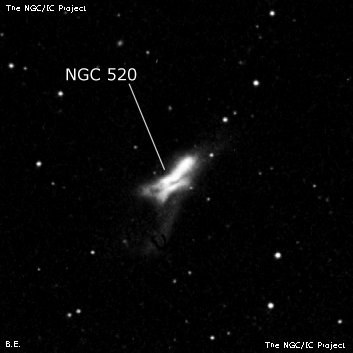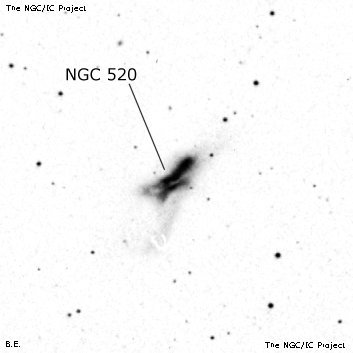NGC/IC Project Restoration Effort
(This is a very very beta version)
NGC520


Basic Information
Location and Magnitude
Right Ascension: 1:24:34.7
Declination: +3:47:39
Constellation: PSC
Visual Magnitude: 11.4
Historic Information
Discoverer: Herschel W.
Year of discovery: 1784
Discovery aperture: 18.7
Observational
Summary description: F, cL, E 137°
Sub-type: Sa/P
Corwin's Notes
=====
NGC 520 is apparently an interacting galaxy. Classified as an I0 by de
Vaucouleurs, the distorted dust lane and unresolved bulge with plumes may be
the result of a collision. Vorontsov-Velyaminov marks three components in his
Atlas of Interacting Galaxies; I've provided positions for them in the table.
However, in the near-infrared, the structure is simpler with a bright peak at
the center connected by a bridge to a somewhat fainter knot to the northwest
(this fainter knot has no optical counterpart). The central peak breaks up
into at least three hot spots in the 2MASS J-band. The J2000.0 positions are
Central peak, K-band: 01 24 34.89 +03 47 30.1
Central peak, H-band: 01 24 34.86 +03 47 29.9
Central peak, J-band: 01 24 34.86 +03 47 28.3 southeast spot
Central peak, J-band: 01 24 34.65 +03 47 35.0 northwest spot
Central peak, J-band: 01 24 35.04 +03 47 33.1 northeast spot
Northwestern knot: 01 24 33.33 +03 48 02.8
The southern of the three optical components (VV 231b) corresponds most
closely to the position of the infrared/radio nucleus.
Steve's Notes
=====
NGC 520
48" (10/22/11): the view of this very bright, highly irregular, disrupted galaxy was fascinating at 488x. The most prominent feature is a very high surface brightness curving "bar" oriented NW-SE (VV 231a), bending out in the middle towards the southwest, and fading out on the southeast end with a faint extension. The total length of the banana-shaped bar is close to 2.5'. The brightest part is at the northwest end, where there is a large, bright knot, 24" diameter that increases to the center. In AJ, 134, 212 (2007), Rossa et all refer to this knot as the northern nucleus. The edge of the bar is very well defined along the north side. At the southeast end of the main bar, the brightness dims sharply but a much fainter hazy glow continues further southeast (VV 231c) and spreads out.
On the south side is a fairly bright, elongated section oriented WNW-ESE (VV 231b), that is separated from the northern "bar" by a prominent, irregular dark lane running NW to SE, paralleling the bar in the central region. A slightly brighter "knot" is located is the middle of the southern section. According to the Rossa paper, the dust lane just north of this knot optically obscures the southern nucleus. At the southeast end, the glow dims rapidly and fans out further southeast.
18" (10/19/06): bright, fairly large, very elongated 3:1 NNW-SSE, 2'x0.6'. This disturbed galaxy has a very unusual appearance with a bright knot at the NNW end. The SSE end is wider and fainter and appears to feather out with a fainter, more delicate section that branches from the main body (VV 231b). The periphery at the SSE end is difficult to trace due to this chaotic structure.
17.5" (1/1/92): fairly bright, moderately large, elongated 5:2 NW-SE, 3.0'x1.2'. Very unusual appearance; the NW portion is noticeably brighter with a bright knot at the NW tip and a mottled texture. Fades towards the SE where it merges into a fainter section which is tilted ~E-W with an irregular surface brightness and ill-defined edges.
8" (11/28/81): faint, diffuse, elongated N-S.



